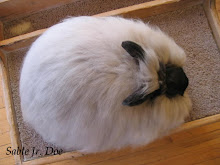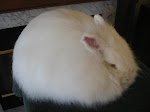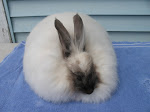-Another post from the old blog:
Wool is without doubt the most difficult thing to learn about an angora rabbit. Bodies take some practice feeling and learning what makes good type and what doesn't, but wool is much more complicated because it varies so much with each individual rabbit. The standard gives an excellent written description of what constitutes a good coat, but you will never know for sure what that means until you get your hands into lots of wool, eyeball it very carefully, and determine for yourself what a balanced coat truly is.
FAs typically have one first baby coat, a second baby coat (or 1st senior coat), and then an increase in guard hair with each successive coat until density and yield begin a total decline around age 3. Many FAs can successfully be shown in their later years, but typically we need to consider the 2nd and 3rd senior coats to be the Prime coats on an FA---the best you'll ever get---the peak of wool condition and quality. When we assess a coat on our rabbits we really need to ignore judge comments on early coats, (strange as that may seem), because a "good" baby coat will almost always be faulted for being too soft. In the very beginning a very young baby will have a preponderance of guard hair but that is only because the underwool has not started to grow in yet. By age 6-8 weeks the balanced coat begins to grow in earnest, and by the time a bunny is 4-5 months old the wool should be quite soft and require grooming approx. every 4 days to keep it healthy and tangle-free. Now, when I say soft I don't mean "cottony", even in the baby coat. Cottony means that when you scrunch the wool together in the palm of your hand it kind of bunches up and sticks to itself. It does NOT fall free, and it has a distinctly "sticky" quality without actually being sticky. Does that make sense, LOLOL?? A cottony coat also has no form, very little shape, and pretty much just sticks out all over the place (when it is in PEAK condition, not when it is on the decline or about to molt).
A good baby coat is soft but still has good texture. It falls free but still has lots of underwool. If you see a baby coat that is primarily guard hair by about 3-5 months, I would consider very carefully whether I wanted to keep that rabbit. Guard hair always increases in an adult coat, and a baby with no underwool will certainly not have any as an adult (which may be rewarded on the show table by judges looking for a "brillo pad" quality, but it is not something you want to perpetuate in your breeding program:( ).
Now, once the baby coat slips, molts, and is harvested, it is time for the 1st senior coat to come in. At this point the wool on a 6-9 month old rabbit should contain guard hair, but it will not be as predominant as the wool in senior coat #2, and you will continue to see a higher ratio of underwool. At this stage you will begin to hear more favorable comments from judges on texture, but they will still say that a coat is often too "soft". I have heard other breeders say that French coats are much softer nowadays, but this is actually not true. What they are most likely seeing are rabbits without fully developed coats who are soft longer because the holding time of the FA has increased, and also density that has improved drastically so that we see FAs with greater underwool as part of a more "balanced" overall coat.
The second senior coat represents the apex of what your rabbit is capable of producing in quality wool in it's lifetime. At this point, you can listen wholeheartedly to judge's comments on texture (provided he/she is a good judge of wool), and use this rabbit for breeding knowing precisely what you will be passing on to the offspring (of course, there is no rule that says you can't breed an FA at 9 months before all this happens:)).
Anyway, a good, correct Senior coat should have neither too much Underwool nor too much Guard Hair. Guard hair should protrude approx. 1/4 inch above the underwool, and when you rub the coat the wrong way (from tail to head) in Prime condition it should drift back into place softly and drape gracefully over the rabbit. There should be a definite shape to the coat. It should be oval and massive, feel strong and lively, and not be coarse or cottony (this is terribly confusing to understand but you will get the hang of it once you feel it often enough:)). If you grab a handful of it a well-textured Prime coat will spring back into place, whereas a dead (slipping or molting) coat will just fall out of your hand and hang limp. Also, you want to try to breed for an even distribution of Guard Hair (not patches of Guards and Underwool all in different places), and remember that the most points on an angora coat are always for density, followed by Texture, followed by Length. Crimp should be evident in the underwool (little zigzags in the strands), and "there should be sufficient underwool to balance the guard hair".
Hope everyone had a wonderful Thanksgiving and see you next time!:-)
Thursday, November 27, 2008
Subscribe to:
Post Comments (Atom)























No comments:
Post a Comment